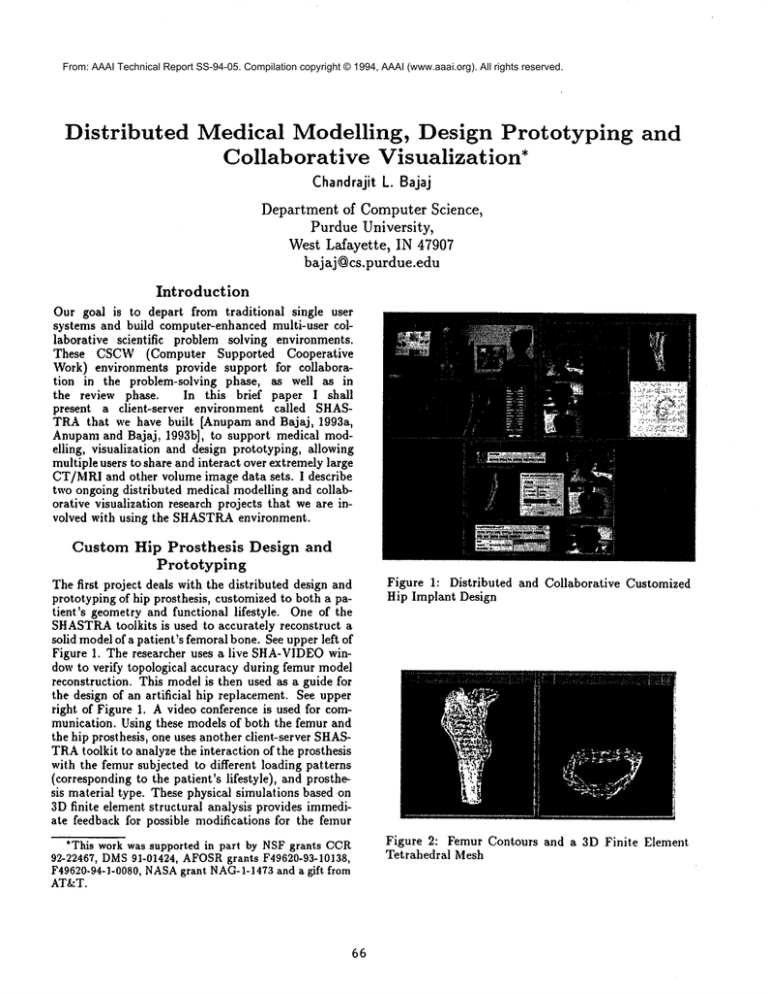
From: AAAI Technical Report SS-94-05. Compilation copyright © 1994, AAAI (www.aaai.org). All rights reserved.
Distributed
Medical Modelling, Design Prototyping
Collaborative Visualization*
and
ChandrajitL. Bajaj
Department of Computer Science,
Purdue University,
West Lafayette, IN 47907
bajaj@cs.purdue.edu
Introduction
Our goal is to depart from traditional
single user
systems and build computer-enhanced multi-user collaborative scientific problem solving environments.
These CSCW (Computer Supported Cooperative
Work) environments provide support for collaboration in the problem-solving phase, as well as in
the review phase.
In this brief paper I shall
present a client-server
environment called SHASTRAthat we have built [Anupam and Bajaj, 1993a,
Anupamand Bajaj, 1993b], to support medical modelling, visualization and design prototyping, allowing
multiple users to share and interact over extremely large
CT/MRIand other volume image data sets. I describe
two ongoing distributed medical modelling and collaborative visualization research projects that we are involved with using the SHASTRA
environment.
Custom Hip Prosthesis
Prototyping
Design and
The first project deals with the distributed design and
prototyping of hip prosthesis, customized to both a patient’s geometry and functional lifestyle. One of the
SHASTRAtoolkits
is used to accurately
reconstruct
a
solidmodelofa patient’s
femoral
bone.Seeupperleftof
FigureI. The researcher
usesa liveSHA-VIDEO
windowto verifytopological
accuracy
duringfemurmodel
reconstruction.
Thismodelis thenusedas a guidefor
thedesignof an artificial
hipreplacement.
Seeupper
rightof Figure1. A videoconference
is usedforcommunication.
Usingthesemodelsof boththefemurand
thehipprosthesis,
oneusesanother
client-server
SHASTRAtoolkit
to analyze
theinteraction
of theprosthesis
withthefemursubjected
to different
loading
patterns
(corresponding
tothepatient’s
lifestyle),
andprosthesismaterial
type.Thesephysical
simulations
basedon
3D finiteelement
structural
analysis
provides
immediatefeedback
forpossible
modifications
forthefemur
Figure 1: Distributed
Hip Implant Design
and Collaborative
Customized
Figure 2: Femur Contours and a 3D Finite
*Thisworkwassupported
in partby NSFgrantsCCR
92-22467,
DMS91-01424,
AFOSRgrantsF49620-93-I0138, Tetrahedral Mesh
F49620-94-I-0080,
NASAgrantNAG-I-1473
anda giftfrom
AT&T.
66
Element
r---- - --_ ---,-,,
v.....___r
gure 3: Selective Visualization of the AverageStress
.lues after Analysis
Figure 4: A Stack ofC1 Smooth Cubic Spline Contours
which are lso-Curves from a Stack of MRIData Slices
)del (for possible bone reaming) and the final pros.=sis design[Bajaj and Schikore, 1993]. See Figure 2
dch shows a 3D finite element model of a humanfelt. Further figure 3 showsa selective visualization of
¯ . average stress values after analysis on a proximal
;ion of the femur. See also bottom of Figure 1. The
dgners again use video-conferencing for communica-
~-’Iand v(y) = and is def ined loc ally for rect angles given by [al _< z _< a~, bl < z < b2]. The desired
1contours in each slice of anatomical data are now C
smooth iso-curves w = constant of this computed density function. In one data partitioning scheme the different data slices are handled by different workstations
(servers) and the results of the iso-curves are communicated and viewed by designated display workstations
(clients). Alternatively, since the piecewise trivariate
interpolants are locally computable, each data slice may
be further subdivided into rectangle~ and processed on
separate workstations. See Figure 4 which shows an
example of this approach used to construct a contour
model of a human head from MRI data.
Another of our distributed
algorithms to construct piecewise approximants works directly in object space. Here the given cuberille volume data is
considered as lying in four dimensional space with
the spatial coordinates z,y,z being three dimensions and the CT/MRI density values yielding the
fourth dimension w. We then fit a C1 smooth
piecewise tri-cubic polynomial function W(z, y, z)
n.
Distributed Volume Modelling and
Collaborative Visualization
e second SHASTRAproject deals with the dis)uted and collaborative visualization of extremely
ge CT/MRIvolume data. The modelling and visual°
tion algorithms uses the computational power ofmulle networked workstations to speedily produce piece;e trivariate interpolants (modelling) and translucent
~ded images of isosurfaces and direct volumerenders of these extremely large volume image data sets
realization).
)he of our distributed algorithms to construct these
cewise approximants utilizes the fact that three dinsional CT/MR1cuberille image data comes in a
:k of parallel slices. In this approach we con-~r each slice data as lying in three dimensional
ce with the spatial coordinates z,y being two dinsions and the CT/MRI density values yielding
third dimension w. We then fit a C1 smooth
:ewise bi-cubic polynomial function W(z,y)
=o ~,~=o wijBa(u(z))B~(v(Y))
to simultaneously"
.~rpolate and least-squares approximate this dense
a, with a small number of polynomial pieces
jaj and Xu, 1993]. Here B’~(t) n= i~ti(1 -t)
ae degree n Bernstein-Bezier polynomial, and u(z)
a~--al
3
3
3
k_-o
to simultaneouslyinterpolate and least-squares approximate this dense volume data, with a small number of polynomial pieces [Bajaj and Xu, ]993]. Here
B.~(t) = ~P(1 -t) n-i is the degree n BernsteinBezier polynomial, and u(z) =
~ v(y) = ..L=h.
and
az-an ’
b2-bl
w(z) z~-c=
and
de
fined
lo
cally
fo
r
cu
boids
gi
ven
by
C2--C 1
[al _< x < a2, bl _< x < b~, cl < x _< c~]. Thedesired surface models of subparts of the anatomical data
are now C1 smooth iso-surfaces w - constant of this
computed volume density function. See Figure 5 which
shows an example of this approach used to construct a
67
Figure5: Visualization
of Modelsof theHeadandthe
BrainwhichareIso-Surfaces
fromtheVolumeCuberille
MRI Data
Figure 6: Using the SHASTRAApplication
POLYfor Collaborative Visualization
called
volume model of a human head from MRI data.
In the first type of algorithm we construct C~ smooth
bi-cubic bivariate interpolants and approximants on
networked workstations, where each server system computes the solution of a linear system with 16 variables.
In thesecondtypeof algorithm
we construct
CI smooth
tri-cubic
trivariate
interpolants
andapproximants
on
networked
workstations,
whereeachserversystemcomputesthesolution
ofa linear
system
with64 variables.
Details
ofthederivation
oftheindividual
linear
systems
are given in [Bajaj and Xu, 1993].
The environment for collaborative visualization consists of a collection of instances of POLY.POLYis a
3-D rendering and visualization tool which has a Motif
based GUI(graphical user interface). The user interface
!
of the POLYvisualization tool are shown in Figure 6.
A collaborative session is initiated by one of the POLY
users in the environment. This user becomes the group
leader and specifies to the local Kernel the list of POLY
users that will be invited to participate in the session,
and becomes the group leader. The Kernel instantiares a Session Manager, which starts a session with the
group leader as its sole participant, and then invites the
! :
specified users of concurrently executing remote POLY
:.^ ,
sessions to participate. Users that accept are incorporated into the session. Any POLYinstance not in the
conference can request admittance, and join. A particFigure 7: Shared Visualization - A group of researchers
ipant can leave an ongoing session at any time. Users
uses SHA-POLY
to share volume visualization
images
can be dynamically invited to join or be removed from
of
a
head
with
cutaways
(top-center
and
right),
and
conferences by the group leader or his designee.
cadaver
(center).
Every participating POLYinstance creates a shared
windowin which all the cooperative interaction occurs.
Users introduce graphics objects into the session by selecting them into the Collaboration Window.The Ses-
68
References
[Anupam and Bajaj, 1993a] V. Anupamand C. Bajaj.
Collaborative Multimedia Scientific Design in SHASTRA. In Prac. of the First ACMInternational
Conference on Multimedia, ACMMULTIMEDIA93,
pages 447-456. ACMPress, 1993.
[Anupam and Bajaj, 1993b] V. Anupamand C. Bajaj.
SHASTRA- An Architecture
for Development of
Collaborative Applications. In Proc. of the Second
Workshopon Enabling Technologies: Infrastructure
for Collaborative Enterprises, pages 155-166. IEEE
Computer Society Press, 1993.
[Bajaj and Schikore, 1993] C. Bajaj and D. Schikore.
The Distributed
Design of Hip Prosthesis using
BHAUTIK.In Proceedings of the 1993 Symposium
on Applied Computing, pages 36 - 39, Indianapolis,
Indiana, 1993.
[Bajaj and Xu, 1993] C. Bajaj and G. Xu. Trivariate
Interpolants and Scientific Visulization. Computer
Science Technical Report, CSD-TR~93-18, Purdue
University, 1993.
’igure 8: Another Site in the Shared Visualization
Manageris responsible for providing access to the
ects at all participating sites which have the Access
mission, and for permitting interaction relevant to
operation at sites which have Modifypermission for
collaboration. Collaborating users can twiddle vilization modes/rod parameters, and adjust viewing
des and direction. The system provides telepointin the shared windows. It also provides indications
emote presence which describe the viewing location
¯ emote users in the collaborative session. Figure 7
¯ 8 depict two sites in a three waycollaborative vilization. The entire volume rendering of Freddy is
red by all collaborating sites - they share the data
the viewing location, as well as visualization conparameters. The collaborators share data sets and
vmg location in the other two renderings of MRI
a sets of the humanhead. However, they use differcutaways to examine different parts of the data.
.t one extreme, the SHASTRA
implementation for
laborative Visualization can be used by a single user
~erform scientific visualizations, just like in a nonaborative setting. Allowing other users to join the
ion with only Access and Browse permissions sets
the environment like an electronic blackboard to
.h novice users the basics of the process. An ap)riate setting of collaboration permissions and turnng can be used to allow hands on experience with
task. In conjunction with the audio and video comlication services of SHASTRA,
this becomes a pow1 instructional environment. Collaborative sessions
g POLYare a valuable tool for review and analysis
roblem solutions. Multimedia communication facilpermit a rapid exchange of rationales for choices,
rpretations of analyses and iterative improvement.
69



